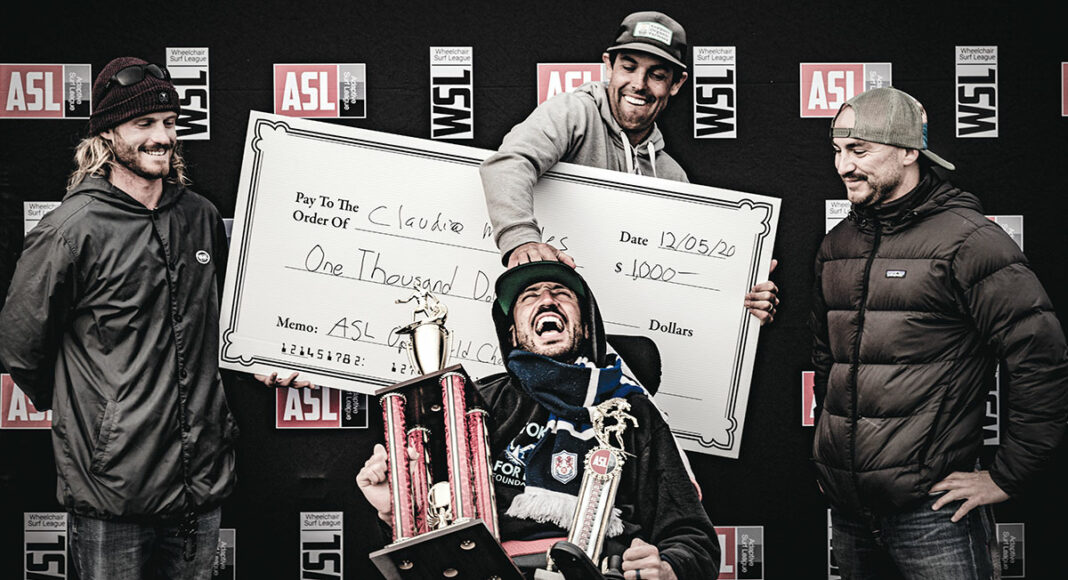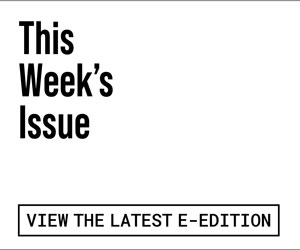The Central Coast was battered with big south swell over the weekend as Steamer Lane hosted the 2020 Adaptive Surf League (ASL) World Championships and Wheelchair Big Wave contest. Santa Cruz surfer and Chilean Paralympics hopeful Claudio Morales rode a custom-made Pearsons to a clean sweep of the contest for his first World Title, also winning the Big Wave competition on Friday.
This year’s Paralympics were disrupted by the pandemic, impacting the field by taking away a chance to compete on the biggest stage. More importantly for ASL athletes, each contest represents a chance to share their stories of athleticism and overcoming adversity.
“No one plans on being in a tragic accident,” says Morales, a regular at surf breaks in this area, who gets around in a wheelchair and surfs lying down on his board. “No one grows up dreaming of this happening to them, but [my accident] wasn’t the end, it was the beginning of something new. To get the chance to be here with my fiance and with my amazing support team of Rob Crompton, Hank Skipp, Jason Shepardson, Scott Dust Marty, and Kyle Marty is sweet. Thank you to all my competitors, and the ASL, for pushing me.”
Photographers like Ben Ingram and Nick Betts came to help capture the moment with drone pilot Ernest Smith. Multiple veteran publications sent journalists to cover riders like Jose Martinez, an Olympic hopeful and big-wave surfer who lost three limbs in Afghanistan.
“This is a huge leap forward for the ASL,” Martinez, an ASL board member, says. “Did you see those waves out there this weekend? It was crazy, the biggest conditions most of us have ever surfed, definitely the biggest waves this contest has ever seen. To ride a world-class surf break on a world-class day, and to get to be on Surfline the whole time, it was firing, man! This wasn’t an epic adaptive surf contest—this was an epic surf contest that adaptive people competed in.”
After the contest wrapped up, Martinez headed home to pack for a big-game bow hunting trip he is scheduled to go on in Texas this weekend.
The ASL managed to snake through a multitude of shutdowns around the state under the California professional athlete exception. With a $1,000 prize on the line, multiple adaptive surfers competed under the watchful eye of support teams and water rescue professionals on Jet Skis.
Since its inception, the ASL has sought to bring the sport into the professional space by offering riders the chance to earn money from sponsorships and contest prizes. Partnering with the International Surfing Association, the two leagues have worked in tandem to make surfing more inclusive while still giving adaptive athletes a place to be celebrated.
“What an amazing weekend, I am so happy everyone got to compete in that amazing swell,” says contest organizer Jeff Munson. “Most of these athletes had their training schedules disrupted over the year, so to come out and go headfirst into huge waves shows you the kind of competitors we’ve got. We are all extremely grateful for the water rescue professionals who provided ski and swimmer support, to the locals who shared their wave with us for a few days, and to the city of Santa Cruz for letting us put on a show.”
Adding to the special vibe is the fact that the contest happened in Santa Cruz, a town with a growing adaptive surf community, much of it organized by veterans.
Army veteran and Santa Cruz local Arturo Ayala has been a vanguard of the movement, hosting monthly surf meetups and facilitating the acquisition of adaptive surf equipment for those who need it. Attendees range in age from their early twenties to late sixties. They all share in open conversations about their experiences in and out of the doctor’s office.
For beginner surfers, groups like Ayala’s One More Wave club represent a whole new world of physical and mental health.
“Surfing, especially in Santa Cruz, can be intimidating,” he says. “We surf as a family and help mentor new surfers in the ways of the wave. Surfing saved my life: It helped me bring fitness back into my life, and it’s been a lifeline in these dark times. Our mission was focused on developing adaptive equipment in the beginning, but now we have dropped in on building veteran surfing communities around the country. Sadly, demand is way higher than availability at this time, so we are trying to give vets somewhere to go check back in with nature.”













